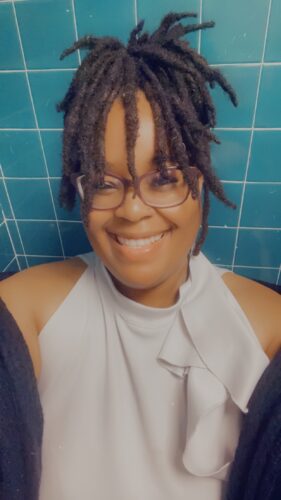Forging New Neurodivergent Futures: An Evolution Through Trauma to Understanding

Early Shadows: The Shaping of a Sensitive Mind
The First Loss
The scent of thickly applied powdered funeral home makeup, caked on the cold forehead of someone I had strongly believed was invincible, still lives in my memory. I was barely school-aged (around age 7) when my Uncle Darren Wayne, my mother’s baby brother who shared my birthday, was shot to death before his 25th birthday. That moment marked the beginning of a childhood where loss and violence became familiar companions, where my young mother’s grief left emotional voids that she wouldn’t be equipped to even address until later in my adulthood, and where survival meant learning to live partly outside my own body.
A Childhood in Flight
Growing up in the 1990s, our lives were an incessant violent pendulum swing between flight and fear. My mother was perpetually running from my father, whose presence always meant danger, whose shadow followed us from home to home until his intentional (self-inflicted) death in a motorcycle accident just before my 13th birthday. These early years shaped my mind into a hypervigilant instrument, always scanning for threats, always processing at maximum capacity. What I didn’t understand then—what would take decades to uncover—was how profoundly these experiences were sculpting my neurodevelopmental path.
Finding Refuge in Stories
Like many highly sensitive children born into chaos, I developed a complex relationship with reality. Books became more than escape – they were oxygen. Stories weren’t just entertainment – they were survival. My mind created elaborate worlds where even the most frightening things made sense. This gift for deep feeling and pattern-seeking became my alchemy for survival, though I wouldn’t understand its deeper significance until much later.

The Search for Safety: Religion as Both Shelter and Prison
Silent Cries
By junior year of high school, these coping mechanisms had evolved into more visible manifestations. During a particularly dark period triggered by religious texts about “unforgivable sins,” I began wearing tape over my mouth – a silent cry for help that unexpectedly resonated with my classmates. When others began mimicking this ritual, school administrators accused me of starting a cult. Looking back now, I recognize this as an early sign of how differently my brain processed information and emotions – though I lacked the framework to understand it then.
The 27-Year Bond
The years that followed were marked by a desperate search for safety and meaning. Religion became both shelter and prison – a trauma bond that would last twenty-seven painful years. Born into a fundamentalist family practice, I projected every need for protection, love, and nurturing onto an Abrahamic representation of the divine. I hid behind the skirts of God, trying to pray everything wrong in my life fixed, taking scripture to extremes in my desperation to feel whole.
Breaking Free
But a traumatized mind with obsessive compulsive tendencies that interpreted things in extremes was no place for philosophies built on condemnation and fear tactics. Broken, neurodivergent minds like mind can’t withstand the relentless urgency and commotion of such invasive belief systems. Constantly creating wreckages of rejection and always taking up the space where peace and relief should be. The unrelenting pressure to conform eventually began to crack my carefully constructed defenses. The depression that had lingered since genesis grew darker, thicker. My devotion transformed into a slow-burning bitter rage as I realized there was no pleasing this god, no end to the rules that seemed to multiply with each passing day. It took be a long time to break free from this indoctrination and this journey is a central part of my journey as this bondage caused me more psychological damage than all the events of my life combined. But I will reserve this story for another day.
Awakening: The Journey Back to Self
Finding Safe Harbor

It wasn’t until age 32, after finally securing my own apartment – my first truly safe space – that the fog began to lift. In that sanctuary of solitude, I started the profound journey of understanding my unique neurocognitive makeup. The simple act of having a safe space to call my own began awakening me from decades of dissociation. Suddenly, as if emerging from a long dream, I became aware of my own physical presence in a way that felt entirely new.
The Path to Understanding
Through intensive research and self-discovery, I began to recognize patterns in myself that transcended traditional diagnostic categories. My experiences didn’t fit neatly into any single box – not quite classical autism, not purely trauma response, not simply anxiety or HSP traits. Instead, I discovered what researchers are increasingly understanding: that early childhood trauma can fundamentally alter brain development in ways that create unique neurodivergent profiles.
Understanding Neurodivergence: Beyond Traditional Labels
A Mosaic of Identity
In my solitude, I discovered the various labels that helped piece together my identity puzzle: “HSP, INFJ, Taurus, Autistic traits, ADHD characteristics, borderline tendencies, genetic disposition to bipolar.” These weren’t just clinical terms but pieces of a complex mosaic, each one helping me understand why I need hours alone to process information, why crowds drain my energy, why certain sounds feel like physical pain, why eye contact requires careful rationing of my internal resources.
Finding Connection
I am a person who finds very little pleasure or peace in human connection. The betrayals, ulterior motives and emotional labor of relationships terrify and exhaust me beyond measure. Of all of the things I’ve prayed for in life, friendship was rarely ever one of them. I find safety in the predictability and control of my own company.
But throughout all seasons of my life, my sister has been a constant companion – a soulmate who created the template of love against which I would measure my future husband’s devotion. Once a childhood rival, became my closest friend and confidante – our bond growing stronger through shared understanding of our unique family history.
At 33 of the romantic soulmate variety love found me in an unexpected way when I met my husband, our connection transcending cultural and geographical distances as he lives in West Africa. These relationships proved that authentic connection is possible when we’re finally able to show up as our true selves.
Creating Sanctuary: The Birth of a Children's Book
A Vision of Understanding
Clarity is priceless, for it is from this profound self-discovery that has expanded thirty-seven whole years, has finally emerged my most heartfelt creative endeavor – a children’s book titled “There’s Not Enough Hours in the Day for People Like Me.” This isn’t just another book; it’s the understanding I wish I’d had as that scared, confused child wearing tape over her mouth. It’s for every young person who feels time differently, who needs space to process, who lives life in vibrant technicolor when others see in muted tones.
Breaking Traditional Bounds
Through alternating waves of prose and rhyme, rich sensory details, and characters who embody different aspects of neurodivergent experience, I’m creating a literary sanctuary where young readers can see themselves reflected with dignity and joy. No pathologizing, no fixing – just pure recognition and celebration of their unique ways of being in the world.
Tools for Navigation
Woven throughout are golden threads of learning – vocabulary words that shimmer with new understanding, “Did You Know?” boxes that illuminate neurodivergent experiences, and practical tools for navigating a world that sometimes feels too much. It’s the resource I would have treasured in my own childhood journey – a compass for navigating the beautiful complexity of a neurodivergent life.

Revolutionary Love: Neurodivergence as Evolutionary Adaptation
Nature's Response
The journey of understanding my neurodivergent identity has led me to a broader realization: perhaps the rising visibility of neurodivergence itself represents a kind of evolutionary adaptation – nature’s response to centuries of societal systems built on disconnection, violence, and lack of empathy. Not as a simplified cause-and-effect relationship, but as part of humanity’s complex journey toward greater consciousness and integration.
Beyond Simple Labels
This perspective must be held carefully, avoiding oversimplification of the intricate interplay between genetics, environment, and neurodevelopment. Neurodiversity isn’t solely a response to societal pressures – it’s a multifaceted phenomenon with various underlying causes, representing the natural variation in human cognition and behavior
Building Bridges: A New Chapter in Human Consciousness
Education as Liberation
“This is why global education is important,” I emphasize, my voice firm with conviction, “so that neurodivergent and atypical people alike can learn how to protect themselves and set boundaries regardless of diagnosis or disorder.” Understanding neurodiversity isn’t just about acceptance – it’s about creating a world where different ways of being can thrive.
From Personal to Universal
From the ashes of early trauma and alienation, I’m not just rebuilding my own sense of self – I’m helping forge new possibilities for neurodivergent expression and acceptance. Each word I write, each story I tell, each moment of authentic self-expression becomes part of a larger tapestry of hope and transformation. By embracing our natural neurodivergence as a gift to humanity’s evolution, we open doors for future generations to step into their full, radiant potential – not despite their differences, but because of them.
A Love Song to Neurodiversity
In the end, this isn’t just my story. It’s a love song to every neurodivergent soul still searching for belonging, a beacon of hope promising that our unique ways of experiencing the world are not just valid – they’re vital to humanity’s continuing journey toward wholeness. Through my book and beyond, I’m creating the safe spaces and understanding I once desperately needed, transforming personal wounds into universal wisdom that lights the way for others.
Connect With the Author
Join the Journey
Follow Sequana Whiteside’s (Auntie Nalorie Oluchi) journey:
- Newsletter: Subscribe to Stardust Salves on Substack | Stardust Salves’ Substack | Stardust Salves & Potions | Substack
- Email:
- General Inquiries: stardust.salves@gmail.com
- Book-Related: auntienaloriesmagicalstories@stardustsalves.com
Join me in creating safe spaces and understanding for neurodivergent minds. Together, we can forge new paths of acceptance and celebration of neurological diversity.

Sequana Whiteside
Website: https://stardustsalves.substack.com/
Email: stardust.salves@gmail.com
LinkedIn: Sequana (Auntie Nalorie Oluchi) Whiteside | LinkedIn
Language: English


7 Comments
I loved your inspiring story Sequana!
Thank you so much joy! Your support is immeasurably appreciated and I am so grateful for this opportunity to not only share my story but further the neurodivergent discussion 🙏🏽🤓
You have a brilliant mind😍 I can’t wait to read your book🤗
Thank you so much my soulmate sister friend 🥰🥰🥰🥰🙏🏽😇😇 I love you so much! Thank you so much for always being my biggest supporter and always in my corner 🤗🤗🤗💕 💕💕 #bestfriendsforever
Sequana, you are an incredible woman! Let us know as soon as your book is released!
Patricia, your support and leadership in championing neurodivergent voices truly inspire me! 🌟 I’m honored to be part of the Divershines community and can’t wait to share updates as the book nears completion. Thank you for helping create spaces where stories like mine can flourish and reach those who need them most. 🙏🏽✨